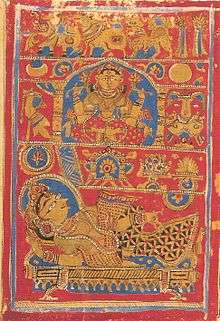Trishala
| Trishala | |
|---|---|
| Mother of last Tirthankara | |
 Kalpa Sūtra miniature of Queen Trishala (bottom) and her auspicious dreams, c. 1472. | |
| Spouse | Siddhartha |
| Parents |
|
| Part of a series on |
| Jainism |
|---|
 |
|
Jain prayers |
|
Ethics |
|
Major figures |
|
Major sects |
|
Festivals |
|
Pilgrimages |
|
|

Trishala also known as Queen Trishala, Trishala Devi, Priyakarini, or Trishala Mata (Mother Trishala) was the mother of Mahavira, the 24th Tirthankara of Jainism, and wife of the Jain monarch, Siddartha of Kundgraam, of present-day Bihar.
She finds mention in the classical Jain Agamas, the Kalpa sutra, which is primarily a biography of the Tirthankaras.
Life
Like her son Mahavira, Trishala was born into royalty. She was daughter of Chetaka, republican president of Vaishali City.eldest daughter[›] As per Indologist Hermann Jacobi, Vardhaman Mahavira's mother Trishala was sister of Chetaka. His third wife, Kshema, was a daughter of the chief of the Madra clan of Punjab.[1] Trishala had seven sisters, one of whom was initiated into the Jain monastic order while the other six married famous kings, including Bimbisara of Magadha and Mahavira's own brother, Nandivardhana. She and her husband Siddhartha were followers of Parshva, the 23rd Tirthankara. According to Jain texts, Trishala carried her son for nine months and seven and a half days during the 6th century BC. However, Svetambaras generally believe that he was conceived by Devananda, the wife of a Brahmin and was transferred to Trishala's womb by Indra because all Tirthankaras have to be Kshatriyas.conception[›]
Auspicious dreams
According to the Jain scriptures, the mother of Tirthankaras see a number of auspicious dreams when the embryo is enliven through the descent of the life (soul) in the mortal body. This is celebrated as Garbha Kalyanaka.[2] According to the Digambara sect, the number of dreams is 16. While the Śvētāmbara sect believe them two be only fourteen. After seeing these dreams, she woke her husband King Siddhartha and told him about the dreams. The next day Siddhartha summoned the scholars of the court and asked them to explain the meaning of the dreams. According to the scholars, these dreams meant that the child would be born very strong, courageous, and full of virtue.
- Dream of an elephant (Airavata)
- Dream of a bull
- Dream of a lion
- Dream of Laxmi
- Dream of flowers
- Dream of a full moon
- Dream of the sun
- Dream of a large banner
- Dream of a silver urn (Kalasha)
- Dream of a lake filled with lotuses
- Dream of a milky-white sea
- Dream of a celestial vehicle (Vimana)
- Dream of a heap of gems
- Dream of a fire without smoke
- Dream of a pair of fish (Digambara)
- Dream of a throne (Digambara)
Legacy
Today members of the Jain religion celebrate the event of the Dreams. This event is called Swapna Darshan and is often part of "Ghee Boli".
The parents of Tirthankaras and their mothers in particular are worshipped among Jains and are frequently depicted in paintings and sculpture.[3]
See also
| Wikimedia Commons has media related to Trishala. |
Content Notes
^ eldest daughter: According to the Jain Shwethambar sect Trishala was the sister of Chetaka and her sisters were instead her nieces.
^ conception: According to the Jain Shwethambar sect, a Brahmin woman named Devananda was the first one to give birth to the son. After she held the son in her stomach, the fetus was then transplanted into Trishala. Jain Digambara sect does not believe that the son was ever held by Devananda.